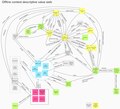New Readers/Industry analysis
Appearance
-
Industry analysis of offline ecosystem
-
Value web describing exchanges in offline ecosystem
Industry analysis
[edit]Offline Wikimedia content
[edit]Fully offline
[edit]There are a number of hardware, software, and content providers working on distributing Wikipedia content offline throughout the world. This deck (also embedded on this page) examines this industry from a few different perspectives for a fuller understanding.
It's possible that there are more offline offerings or distributors - please let us know if you're aware of any and we will add them.
Partially offline
[edit]- The Wikipedia Apps have a "save for later" feature that allows users to bookmark articles. Those articles are later available offline, but can't be shared.
- Downloading content.
- Wikibooks
- Screenshots
- Progressive web apps
- Prototypes
- RFC for an API driven frontend
- ServiceWorker Phabricator task to provide offline support and progressive loading
Other affordability work
[edit]There are many other NGOs, companies, and governments around the world working on providing affordable internet access. We'll collect information here about what else we learn about.
- The Indian state Kerala commits to providing free wifi to all of its citizens.
- We are gathering some of what we learn in a google spreadsheet. This is definitely WIP.
Other offline support
[edit]- Youtube India supports downloading videos for offline viewing, and on some networks can do this during off-peak hours.
- URL to PDF makes a PDF out of a website.
- send to apps/sites for reading offline (instapaper, pocket, etc)
- google drive is available offline
- mobile chrome (and maybe other browsers) offer print-->pdf
- Printing websites into books: http://theanarchistlibrary.org/library/emma-goldman-alexander-berkman-s-last-days
Offline sharing
[edit]- Sideloading
- Xender allows device-to-device transfering of files (pictures, videos, music, documents, apps). It works 1:1 or 1:many. Available for Android, iOS, and Windows phones.
- SHAREit (by Lenovo)
- ShareApp
- P2P


